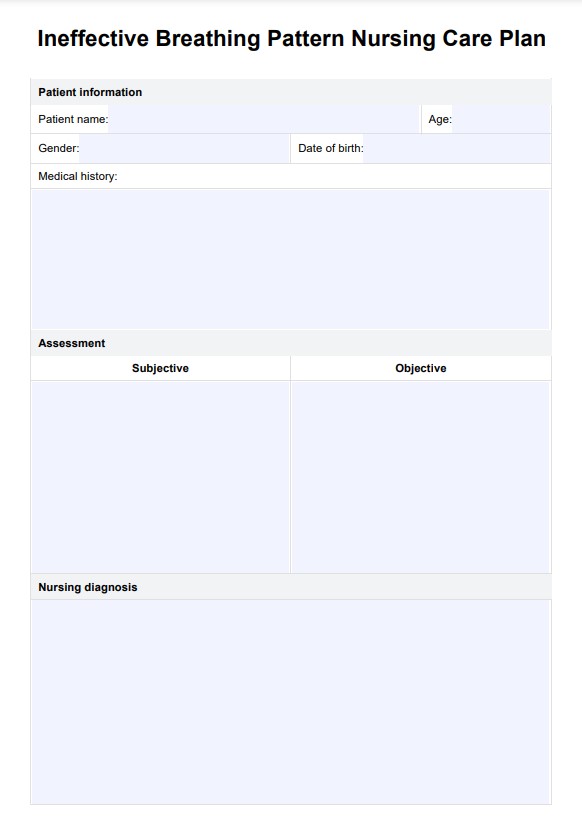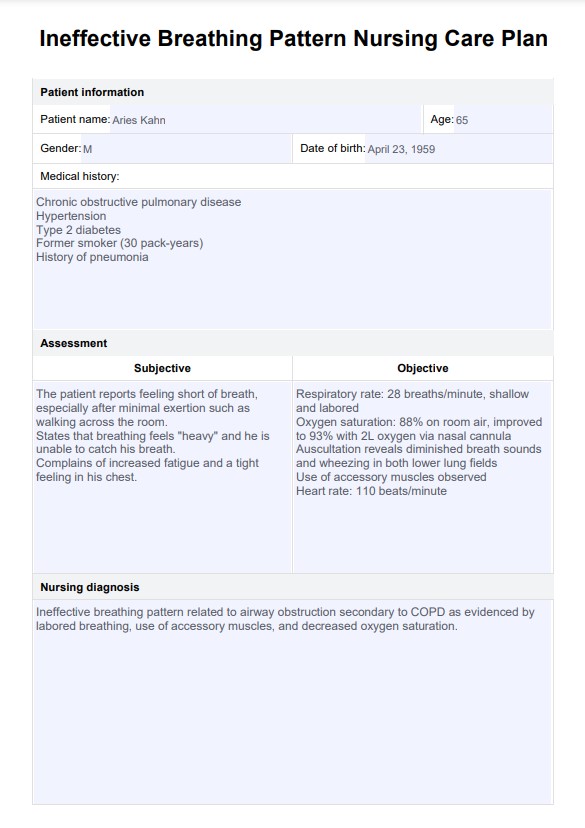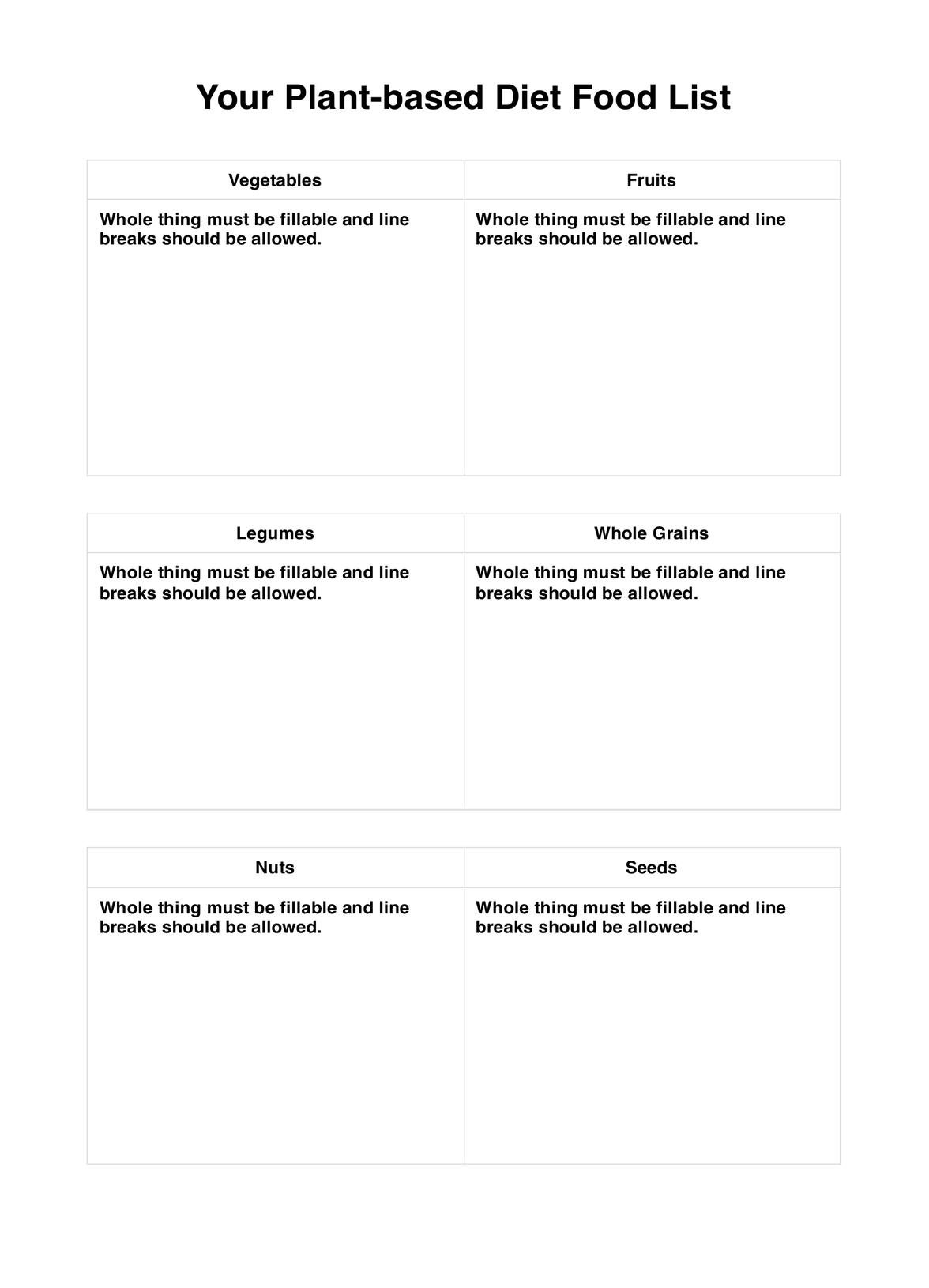Ineffective Breathing Pattern Nursing Care Plan
Streamline patient care with our Ineffective Breathing Pattern Nursing Care Plan template, ideal for effective respiratory management.


What is an Ineffective Breathing Pattern Nursing Care Plan template?
An Ineffective Breathing Pattern Nursing Care Plan template is a form used by nurse to document and plan the care of patients experiencing respiratory issues. The template typically has specific fields to guide the process of assessing, diagnosing, and addressing the patient's breathing problems:
- Assessment: This section captures both subjective data (what the patient reports, like difficulty breathing) and objective data (what the nurse observes, such as increased respiratory rate, cyanosis, or abnormal lung sounds). It helps in identifying the severity and specifics of the breathing issue.
- Nursing diagnosis: Based on the assessment, the nurse formulates a nursing diagnosis, which outlines the main problem and its potential causes (e.g., asthma, chronic obstructive pulmonary disease, or pneumonia).
- Goals and outcomes: This part of the template allows for setting clear, measurable objectives. For instance, the goal could be stabilizing the patient's respiratory rate or improving oxygen saturation levels within a certain time frame.
- Nursing interventions: In this section, nurses document the actions they will take to address the breathing issue. Interventions might include adjusting the patient's position, administering oxygen, or providing medications.
- Rationale: This field provides the reasoning behind each intervention, ensuring that each action is evidence-based and tied to clinical knowledge.
- Evaluation: After the interventions are implemented, the nurse evaluates their effectiveness by reassessing the patient. This section documents any progress or adjustments needed in the care plan.
This template ensures comprehensive, consistent care by guiding the nurse through a logical, step-by-step process of managing respiratory issues.
Ineffective Breathing Pattern Nursing Care Plan Template
Ineffective Breathing Pattern Nursing Care Plan Example
How to use our free Ineffective Breathing Pattern Nursing Care Plan template
Carepatron's free Ineffective Breathing Pattern Nursing Care Plan template is designed to make nurses' clinical documentation hassle-free. Here's how to use it:
Step 1: Download the template
Get a copy of the Ineffective Breathing Pattern Nursing Care Plan for pneumonia by clicking "Use Template" This allows you to utilize the resource via the Carepatron app. For a PDF copy, click "Download".
Step 2: Personalize the care plan
Fill in the necessary information about your patient and complete the care plan accordingly. This includes identifying the patient's existing breathing pattern, potential risk factors for ineffective breathing, and any interventions to be used.
Step 3: Implement the care plan
Once personalized, share the care plan with your team and begin implementation. Make sure to regularly update it as needed based on changes in the patient's condition or response to treatment.
Step 4: Evaluate and adjust
Regularly monitor the effectiveness of the care plan and make necessary adjustments. This could include changing medication dosages, adjusting oxygen levels, or implementing additional interventions.
When would you use this template?
The Ineffective Breathing Pattern Nursing Care Plan template is a versatile tool used across various healthcare settings. It is particularly beneficial in:
- Critical care units: Ineffective breathing patterns are common in critical care patients due to various underlying conditions such as respiratory distress syndrome, pneumonia, and acute respiratory failure. This template helps nurses systematically assess and manage these patients' breathing patterns.
- Emergency departments: Patients presenting with acute shortness of breath or other respiratory symptoms require prompt assessment and interventions to prevent further deterioration. The Ineffective Breathing Pattern Nursing Care Plan template provides a structured approach for nurses to quickly identify potential causes and initiate appropriate interventions.
- Pulmonary rehabilitation programs: Patients with chronic respiratory conditions may experience ineffective breathing patterns due to decreased lung function. Healthcare professionals in pulmonary rehabilitation programs can use this template to monitor and manage these patients' breathing patterns.
- Home healthcare: Patients with chronic respiratory conditions may require ongoing monitoring of their breathing patterns to prevent exacerbations and improve overall quality of life. Home healthcare nurses can also use this template to develop individualized care plans for these patients.
- Nursing education: Nursing students can also benefit from using this template as a learning tool to understand the importance of assessing and managing ineffective breathing patterns in various patient populations.
Common nursing interventions for ineffective breathing pattern
Managing an ineffective breathing pattern requires a targeted approach to support the patient's respiratory function and prevent complications such as respiratory distress or respiratory failure. Below are some essential nursing interventions designed to improve respiratory function, ensure adequate ventilation, and promote an effective breathing pattern:
Monitor oxygen saturation
Regularly monitoring the patient’s oxygen saturation (SpO2) is critical in identifying early signs of respiratory distress or respiratory failure. Using a pulse oximeter, the nurse can ensure that oxygen levels are within the normal range or usually above 92% (Ernstmeyer & Christman, 2021). If oxygen saturation drops, this can indicate inadequate ventilation or a worsening condition that may require immediate intervention, such as supplemental oxygen.
Administer supplemental oxygen
Administering supplemental oxygen is often necessary to maintain adequate ventilation for patients experiencing hypoxia or respiratory distress. Oxygen therapy helps improve oxygen saturation and supports the respiratory system. The nurse should titrate oxygen delivery based on the patient’s condition and arterial blood gas (ABG) results to avoid hyperoxia or oxygen toxicity.
Encourage use of breathing techniques
Teaching breathing exercises can promote effective breathing in patients showing signs of an ineffective breathing pattern, especially those using accessory muscles to breathe. One such technique is pursed-lip breathing, which helps slow the respiratory rate and improve oxygen exchange in the lungs (Nguyen & Duong, 2023). This intervention is particularly beneficial for patients with obstructive respiratory diseases.
References
Ernstmeyer, K., & Christman, E. (2021). Chapter 11 oxygen therapy. National Library of Medicine; Chippewa Valley Technical College. https://www.ncbi.nlm.nih.gov/books/NBK593208/
Nguyen, J., & Duong, H. (2023, July 25). Pursed-lip breathing. PubMed; StatPearls Publishing. https://www.ncbi.nlm.nih.gov/books/NBK545289/
Commonly asked questions
An ineffective breathing pattern related to pneumonia is often evidenced by an increased respiratory rate, a shallow and irregular breathing rhythm, and the use of accessory muscles for respiration. Patients may also exhibit signs of distress, such as nasal flaring and cyanosis. These patterns indicate the body's struggle to maintain adequate oxygen levels due to the inflammation and fluid accumulation in the lungs caused by pneumonia.
The breathing pattern of pneumonia is often characterized by an increased respiratory rate and shallow, irregular breaths. This is due to the body's efforts to compensate for the decreased lung function caused by inflammation and fluid buildup in the lungs.
The nursing care plan for pneumonia may include administering prescribed antibiotics and other medications, monitoring vital signs and oxygen saturation levels, providing supplemental oxygen as needed, and encouraging deep breathing exercises to improve lung function. It also involves assessing the patient's respiratory status regularly and monitoring for any changes or complications. Additionally, nurses play a crucial role in educating patients on proper coughing techniques, maintaining adequate hydration, and promoting rest to aid in the recovery process.

.jpg)










































































































